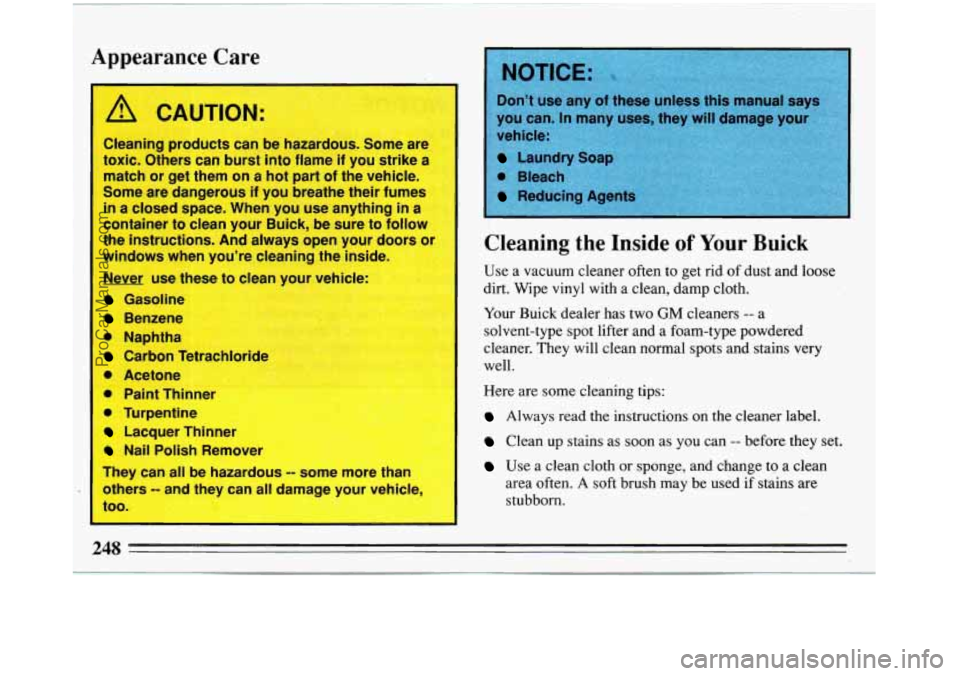Page 220 of 308
A CAUTION:
If you get gasoline on you and then something
ignites it, you could be badly burned. Gasoline
can spray out on you if you open the fuel filler
cap too quickly, This spray can happen if your
tank is nearly full, and: is more likely in hot
weather. Open the fuel filler cap slowly and wait
for any “hiss” noise to stop. Then unscrew the
cap all the way.
When you put the cap back on, turn it to the right until
you hear a clicking noise.
If you need a new cap, be sure to get the right
type. Your dealer can get one for you.
If you get
the wrong type, it may not fit
or have proper
venting, and your fuel tank and emissions system might be damaged.
Checking Things Under the Hood
Hood Release
To open the hood, first pull
the handle inside the
vehicle. It is located on the
floor next to the driver’s
seat.
218
.-
ProCarManuals.com
Page 250 of 308

I Appearance Care
Cte ing products can be hazardc ;. Some are
toxrc. Others can burst into flame
IT you strike a
match or get them on a hot part of the vehicle.
Some are dangerous if you breathe their fumes
in a closed space. When you use anything in a
container to clean your Buick, be sure to follow
the instructions. And always open your doors
windows when you’re cleaning the inside.
Never use these to clean your vehicle:
Gasoline
Benzene
0 Naphtha
Carbon Tetrachloride
0 Acetone
0 Paint Thinner
0 Turpentine
Lacquer Thinner
Nail Polish Remover
1. r Dthers -- and they can all damage your
hey
can all be hazardous
-- some more than
vehicle.
too-
I
NOTICE
Don’t use any of these unless this manual says
you can.
In manv uses, thev wilt damage your
vehicle:
Laundry Soap
0 Bleach
Reduci
I Cleaning the Inside of Your Buick
I Use a vacuum cleaner often to get rid of dust and loose
dirt. Wipe vinyl with a clean, damp cloth.
Your Buick dealer has two
GM cleaners -- a
solvent-type spot lifter and a foam-type powdered
cleaner. They will clean normal spots and stains very
well.
Here are some cleaning
I
I
I
Always read the instructions on the cleaner label.
Clean up stains as soon as you can -- before they set.
I
Use a clean cloth or sponge, and charige to a clean
area often. A soft brush may be used
if stains are
stubborn.
ProCarManuals.com
Page 277 of 308

conditioning condenser. Wash the pressure cap and
neck.
To help ensure proper operation, we recommend a
pressure test of both the cooling system and the
pressure cap.
7. Transaxle Service -- Change both the fluid and
filter every
15,000 miles (25 000 km) if the vehicle
is mainly driven under one or more of these
conditions:
0 In heavy city traffic where the outside
temperature regularly reaches
90 F (32 C) or
higher.
In hilly or mountainous terrain.
When doing frequent trailer towing.
Uses such as found in taxi, police car or delivery
If you do not use your vehicle under any of these
conditions, change both the fluid and filter every
100,000 miles ( 160 000 km).
service.
8. Spark Plug Replacement* -- Replace
spark plugs
with the proper type. See “Specifications Chart” in
the Index.
9. Spark Plug Wire Inspection”? -- Inspect for
burns, cracks or other damage. Check the boot fit at
the distributor and at the spark plugs. Replace wires
as needed.
10.
Air Cleaner Filter Replacement* -- Replace every
30,000 miles (50 000 km) or more often under dusty
conditions. Ask your dealer for the proper
replacement intervals for your driving conditions.
11
.. Fuel Tank, Cap and Lines Inspection”? -- Inspect
fuel tank, cap and lines (including fuel rails and
injection assembly, if equipped) for damage or leaks.
Inspect fuel cap gasket for an even filler neck
imprint or any damage. Replace parts as needed.
Periodic replacement of the fuel filter is not required.
275
ProCarManuals.com